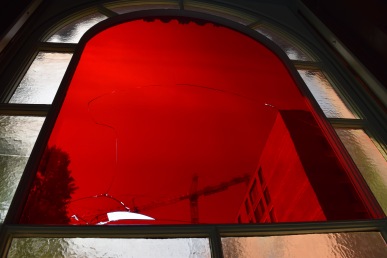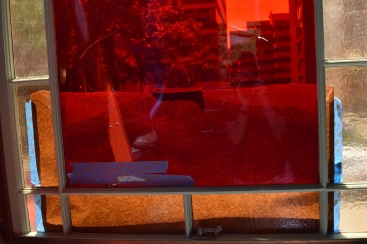As a house museum’s building ages, it is inevitable that some components will require conservation or restoration, but with care and vigilance, these problems can often be predicted and mitigated. Unfortunately, this is not always the case.
One day in late May 2018, the museum had to face one such instance. Vandals threw  some rocks at the museum’s Conservatory, breaking one of the original (c. 1894) panes of red flash glass. Some shards of the glass fell from the window out into the street below, and the rocks were found lying in the sidewalk nearby with telltale bits of green paint from where they had struck the side of the building. While we do not know why someone would have done this, we could only move forward to figure out how to fix it and use this as a learning opportunity.
some rocks at the museum’s Conservatory, breaking one of the original (c. 1894) panes of red flash glass. Some shards of the glass fell from the window out into the street below, and the rocks were found lying in the sidewalk nearby with telltale bits of green paint from where they had struck the side of the building. While we do not know why someone would have done this, we could only move forward to figure out how to fix it and use this as a learning opportunity.
In order to protect the window from further damage, we first placed a low-tack tape over the area with the most breakage on the window to prevent any more shards from shifting or falling. Then, we removed the window sash and  disconnected it from its copper ribbon counterbalance system. Since the windows are so large and heavy, the counterbalance system – which employs a pulley, a weight, and a chain or cord to help bear the weight of the window – makes it easier to open and close. While a metal chain or rope would have traditionally been employed, our Conservatory windows feature the uncommon use of a copper ribbon. The Heurich family used a chain pulley system on most of their windows, including two of the Conservatory windows that were added in the 1920s, so it is a mystery why the copper ribbon was used in the original Conservatory windows. Given the sheer size and weight of the window sashes, the counterweights had to be carefully secured before we detached them from the window, in order to prevent the weights from crashing to the ground upon being removed from the window sash.
disconnected it from its copper ribbon counterbalance system. Since the windows are so large and heavy, the counterbalance system – which employs a pulley, a weight, and a chain or cord to help bear the weight of the window – makes it easier to open and close. While a metal chain or rope would have traditionally been employed, our Conservatory windows feature the uncommon use of a copper ribbon. The Heurich family used a chain pulley system on most of their windows, including two of the Conservatory windows that were added in the 1920s, so it is a mystery why the copper ribbon was used in the original Conservatory windows. Given the sheer size and weight of the window sashes, the counterweights had to be carefully secured before we detached them from the window, in order to prevent the weights from crashing to the ground upon being removed from the window sash.
We then completely removed the upper window sash with the broken pane from the window well, and sealed its open space from the elements temporarily with a sheet of plexiglass. Little did we know, this “temporary” fix would remain in place for a little over a year.
With the window sash out, we next examined the damage to determine if  the glass could be stabilized and restored. Unfortunately, the impact of the rocks had shattered some pieces completely, and the strain on the glass due to its size had caused the window to crack all the way through, edge to edge. We sought several expert opinions, and in the end, it was unanimous: it would not be possible to fix the glass with any permanence.
the glass could be stabilized and restored. Unfortunately, the impact of the rocks had shattered some pieces completely, and the strain on the glass due to its size had caused the window to crack all the way through, edge to edge. We sought several expert opinions, and in the end, it was unanimous: it would not be possible to fix the glass with any permanence.
With the original glass no longer viable, we sought to replace the glass with the most historically accurate reproduction possible. The outlook at first seemed grim – there were only a handful of resalers in the world that sold the same type of glass, and even fewer that manufactured it. This is due to the fact that the original Conservatory windows are made with a technique called flash or flashed glass.

What this means is that instead of the red coloring being throughout the whole sheet of glass, the color is achieved by mouthblowing a thin coating of red colored glass on top of a base of clear glass. The “flash” process involves the molten red glass being picked up by the glassblower, then having the clear base glass added and blown together evenly into a cylinder and eventually cut into a sheet. This technique requires a tremendous amount of skill and experience. Historically, this was a cheaper way to produce colored glass, particularly red glass, as the clear base was less expensive than the red pigment. The flash glass technique also allowed for the glass to be more translucent, making it a more suitable choice for a colored window.
Today, only two main commercial manufacturers in the world still employ this technique: Lamberts/Bendheim and Verrerie Saint-Just/Saint-Gobain. Both manufacturers still produce large sheets of red flash glass up to 100cm. The only problem now was that our window was 110cm at its widest point. It was not a matter of will, but rather a matter of physical ability and expertise of the glassblower, and to our relief, Saint-Just was willing to try.
 After providing them a sample fragment of our glass to match the color exactly (lucky for us it matched their stock medium Red perfectly) and a template for size, all we could do was wait while they made a few test batches.
After providing them a sample fragment of our glass to match the color exactly (lucky for us it matched their stock medium Red perfectly) and a template for size, all we could do was wait while they made a few test batches.
Ultimately they were successful, and after almost exactly one year from the incident, our replacement glass was finally on its way to the museum, all the way from France.
While the glass was being produced, the museum’s  Preservation Manager, Dan Rudie, removed the broken glass from the window sash on site and primed the window so it would be ready for the new glass.
Preservation Manager, Dan Rudie, removed the broken glass from the window sash on site and primed the window so it would be ready for the new glass.
Once the glass arrived, we inspected the sheet for any potential damage in transit, then, finding none, carefully installed it into the historic window sash. At long last, on the first sunny day in July, the window sash with its new red flash glass was put back in its proper place.
Next time you visit us, make sure to take a look at our Conservatory and admire the skill and hard work of Saint-Just and see if you can even tell which window sash their glass is in!

For more information on Saint-Just, visit their website https://www.saint-gobain.com/en/saint-gobain-stories/discover-magic-saint-just-blown-glass
For more information on the flash glass process, visit https://www.lamberts.de/en/products/flashed-glass/


